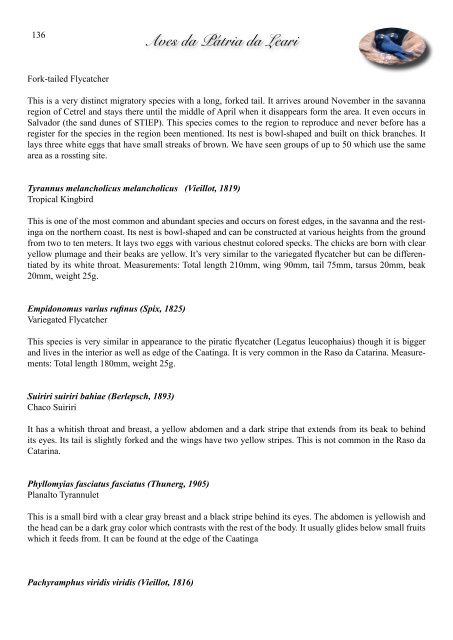Aves da Pátria da Leari - Sociedade Brasileira de Ornitologia
Aves da Pátria da Leari - Sociedade Brasileira de Ornitologia
Aves da Pátria da Leari - Sociedade Brasileira de Ornitologia
You also want an ePaper? Increase the reach of your titles
YUMPU automatically turns print PDFs into web optimized ePapers that Google loves.
136<br />
Fork-tailed Flycatcher<br />
<strong>Aves</strong> <strong>da</strong> <strong>Pátria</strong> <strong>da</strong> <strong>Leari</strong><br />
This is a very distinct migratory species with a long, forked tail. It arrives around November in the savanna<br />
region of Cetrel and stays there until the middle of April when it disappears form the area. It even occurs in<br />
Salvador (the sand dunes of STIEP). This species comes to the region to reproduce and never before has a<br />
register for the species in the region been mentioned. Its nest is bowl-shaped and built on thick branches. It<br />
lays three white eggs that have small streaks of brown. We have seen groups of up to 50 which use the same<br />
area as a rossting site.<br />
Tyrannus melancholicus melancholicus (Vieillot, 1819)<br />
Tropical Kingbird<br />
This is one of the most common and abun<strong>da</strong>nt species and occurs on forest edges, in the savanna and the restinga<br />
on the northern coast. Its nest is bowl-shaped and can be constructed at various heights from the ground<br />
from two to ten meters. It lays two eggs with various chestnut colored specks. The chicks are born with clear<br />
yellow plumage and their beaks are yellow. It’s very similar to the variegated flycatcher but can be differentiated<br />
by its white throat. Measurements: Total length 210mm, wing 90mm, tail 75mm, tarsus 20mm, beak<br />
20mm, weight 25g.<br />
Empidonomus varius rufinus (Spix, 1825)<br />
Variegated Flycatcher<br />
This species is very similar in appearance to the piratic flycatcher (Legatus leucophaius) though it is bigger<br />
and lives in the interior as well as edge of the Caatinga. It is very common in the Raso <strong>da</strong> Catarina. Measurements:<br />
Total length 180mm, weight 25g.<br />
Suiriri suiriri bahiae (Berlepsch, 1893)<br />
Chaco Suiriri<br />
It has a whitish throat and breast, a yellow abdomen and a <strong>da</strong>rk stripe that extends from its beak to behind<br />
its eyes. Its tail is slightly forked and the wings have two yellow stripes. This is not common in the Raso <strong>da</strong><br />
Catarina.<br />
Phyllomyias fasciatus fasciatus (Thunerg, 1905)<br />
Planalto Tyrannulet<br />
This is a small bird with a clear gray breast and a black stripe behind its eyes. The abdomen is yellowish and<br />
the head can be a <strong>da</strong>rk gray color which contrasts with the rest of the body. It usually gli<strong>de</strong>s below small fruits<br />
which it feeds from. It can be found at the edge of the Caatinga<br />
Pachyramphus viridis viridis (Vieillot, 1816)

















